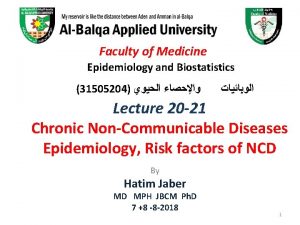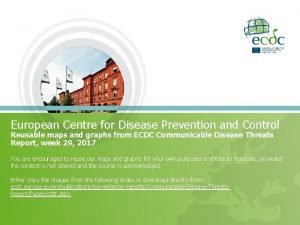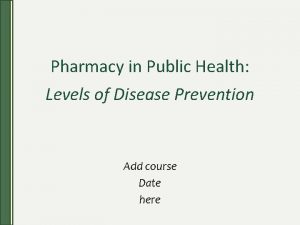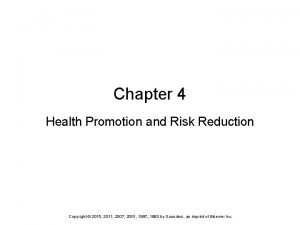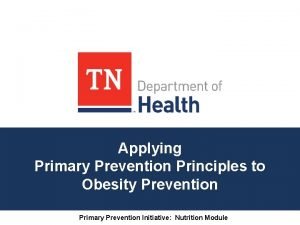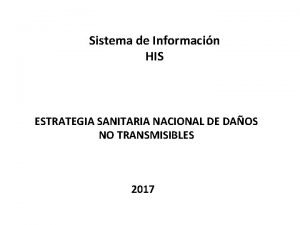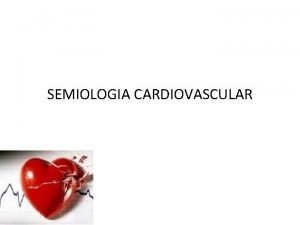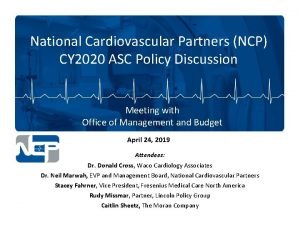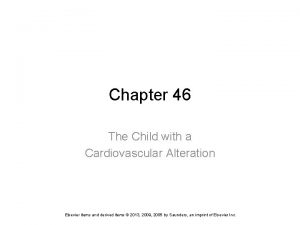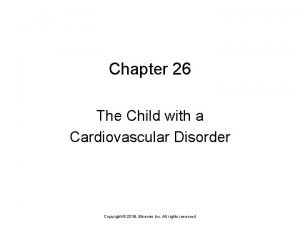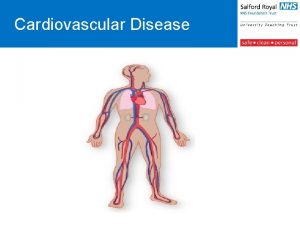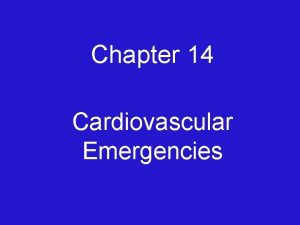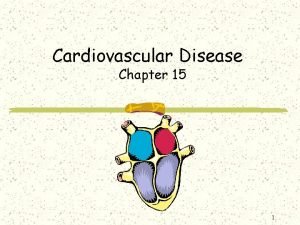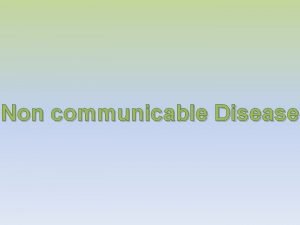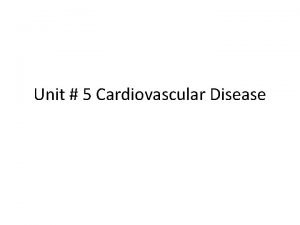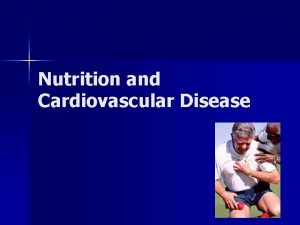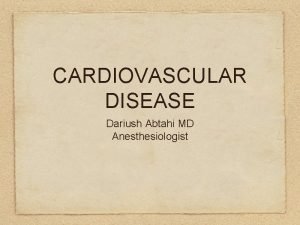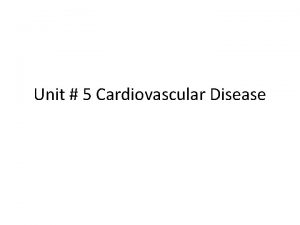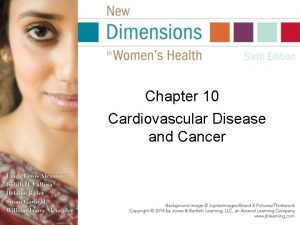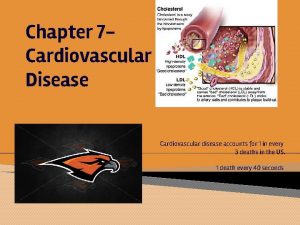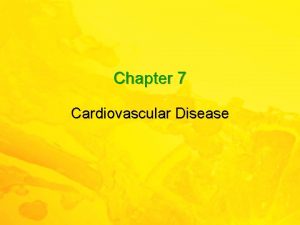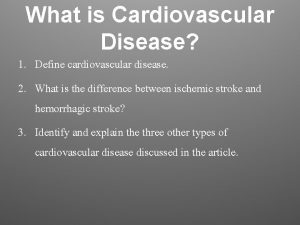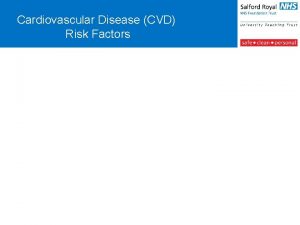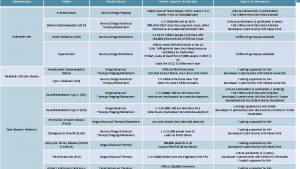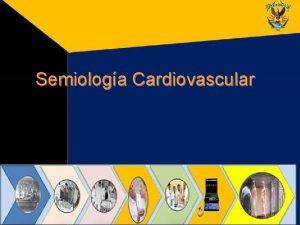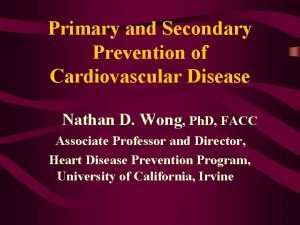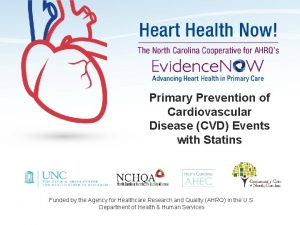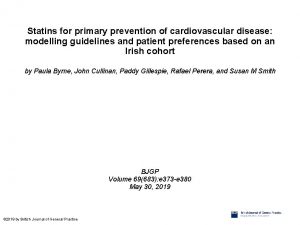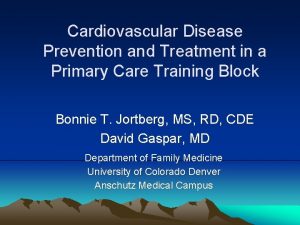Primary Prevention in Cardiovascular Disease PRIMARY PREVENTION OF



























- Slides: 27

Primary Prevention in Cardiovascular Disease PRIMARY PREVENTION OF CARDIOVASCULAR DISEASE Elgar Enamzadeh MD Assisstant professor of cardiology Tabriz university of medical science

Primary Prevention in Cardiovascular Disease Lifestyle Factors Affecting Cardiovascular Risk Exercise and Physical Activity

Primary Prevention in Cardiovascular Disease

Primary Prevention in Cardiovascular Disease The numerous health benefits of regular physical activity have been well established , and physical activity is a cornerstone of maintaining and improving cardiovascular health. Nevertheless, approximately half of adults in the United States do not meet the minimum physical activity recommendations. Strategies are needed to increase physical activity at both the individual and the population levels. Extensive observational data from meta-analyses and systematic reviews support recommendations for aerobic physical activity to lower ASCVD risk. Resistance exercise should also be encouraged because of its several health benefits, including improving physical functioning, improving glycemic control in individuals with diabetes, and possibly BP lowering. Whether resistance exercise lowers ASCVD risk is unclear.

Primary Prevention in Cardiovascular Disease Aerobic physical activity is generally very safe. However, sedentary individuals starting an exercise program should initiate exercise at a lower intensity (eg, slow walking) and duration and progress gradually to recommended levels. It is uncertain whether an upper limit of habitual exercise, either in amount or intensity, may have adverse cardiovascular consequences. But, in discussions with patients, it should be mentioned that these very high levels of physical activity (ie, >10 times the minimum recommended amount) pertain to only a small fraction of the population. Individuals with significant functional impairments may need modifications to and more specific guidance on the type, duration, and intensity of physical activity

Primary Prevention in Cardiovascular Disease Recommendation-Specific Supportive Text 1. Physical activity assessment and counseling in the healthcare setting have important complementary roles in promoting increased physical activity. Ascertaining physical activity patterns during a standard clinical visit is the first step toward effective counseling and can be accomplished through several available simple assessment tools. The results of these tools can be recorded in the electronic health record, along with parameters such as weight and BP , Physical activity counseling by clinicians can result in modest improvements in physical activity levels, with a number needed to counsel as low as 12 for an individual to achieve recommended physical activity levels. This counseling might include an exercise prescription that consists of recommended frequency, intensity, time (duration), and type of exercise.

Primary Prevention in Cardiovascular Disease Recommendation-Specific Supportive Text 2. There is a consistent, strong, inverse dose–response relationship between the amount of moderate to vigorous physical activity and incident ASCVD events and death. The shape of the dose–response relationship is curvilinear, with significant benefit observed when comparing those engaging in little or no physical activity with those performing moderate amounts. All adults should engage in at least 150 minutes per week of accumulated moderate-intensity aerobic physical activity or 75 minutes per week of vigorousintensity aerobic physical activity (or an equivalent combination of moderate and vigorous activity) to lower ASCVD risk (Table 4)

Primary Prevention in Cardiovascular Disease Recommendation-Specific Supportive Text These recommendations are in line with those of other health organizations. Shorter durations of exercise seem to be as beneficial as longer ones (eg, ≥ 10 -minute bouts), and thus the focus of physical activity counseling should be on the total accumulated amount. Additional reduction in ASCVD risk is seen in those achieving higher amounts of aerobic physical activity (>300 minutes per week of moderate-intensity aerobic physical activity or 150 minutes per week of vigorous-intensity aerobic physical activity). There is a continued but diminishing additive benefit of further increasing physical activity to very high levels. Specific exercise recommendations for the prevention of heart failure may differ slightly because the dose–response relationship with increasing physical activity levels may be linear.

Primary Prevention in Cardiovascular Disease Recommendation-Specific Supportive Text 3. There is likely no lower limit on the quantity of moderate-to-vigorous physical activity at which benefits for ASCVD risk start to accrue. All efforts should be made to promote achievement of the minimum recommended amount of physical activity by all adults. However, for individuals unable to achieve this minimum, encouraging at least some moderate-to-vigorous physical activity among those who are inactive (ie, no moderate-to-vigorous physical activity) or increasing the amount in those who are insufficiently active is still likely beneficial to reduce ASCVD risk. Strategies to further increase physical activity in those achieving less than targeted amounts should be implemented.

Primary Prevention in Cardiovascular Disease Recommendation-Specific Supportive Text 4. Despite the focus on moderate- and vigorous-intensity physical activity, such activity accounts for a small proportion of individuals’ daily time as compared with other forms of activity. Other activity states that comprise a 24 -hour period for an average individual include sleep, light-intensity physical activity, and sedentary behavior (Figure 1). Sedentary behavior refers to waking behavior with an energy expenditure of ≤ 1. 5 metabolic equivalents while in a sitting or reclining posture (Table 4). Increased sedentary behavior is associated with worse health parameters, including cardiometabolic risk factors. Sedentary behavior may be most deleterious to ASCVD risk for individuals who engage in the least amount of moderate to vigorous physical activity

Primary Prevention in Cardiovascular Disease Recommendation-Specific Supportive Text Thus, strategies to reduce sedentary behavior, particularly in those not achieving current recommended physical activity levels, may be beneficial for lowering ASCVD risk. However, data on the value of reducing or modifying sedentary behavior over time to reduce ASCVD risk are sparse, and whether replacing sedentary behavior with light-intensity activity (eg, slow walking, light work) is beneficial for ASCVD prevention is unclear. The strength and specificity of the recommendation to reduce sedentary behavior are limited by uncertainty about the appropriate limits of and optimal approach to modifying sedentary behavior

Primary Prevention in Cardiovascular Disease

Primary Prevention in Cardiovascular Disease

Primary Prevention in Cardiovascular Disease

Primary Prevention in Cardiovascular Disease Lifestyle Factors Affecting Cardiovascular Risk Smoking & Cessation of tobacco use

Primary Prevention in Cardiovascular Disease

Primary Prevention in Cardiovascular Disease Tobacco use is the leading preventable cause of disease, disability, and death in the United States. Smoking and smokeless tobacco (eg, chewing tobacco) use in-creases the risk of all-cause mortality and is a cause of ASCVD. Secondhand smoke is a cause of ASCVD and stroke, and almost one-third of CHD deaths are attributable to smoking and exposure to secondhand smoke. Even low levels of smoking in-crease risks of acute MI; thus, reducing the number of cigarettes per day does not totally eliminate risk. Healthy People 2020 recommends that cessation treatment in clinical care settings be expanded, with access to proven cessation treatment provided to all tobacco users. Electronic Nicotine Delivery Systems (ENDS), often called e-cigarettes, are a new class of tobacco product that emit aerosol containing fine and ultrafine particulates, nicotine, and toxic gases that may increase risk of cardiovascular and pulmonary diseases. Arrhythmias and hypertension with e-cigarette use have also been reported. Chronic use is associated with persistent increases in oxidative stress and sympathetic stimulation in young, healthy subjects.

Primary Prevention in Cardiovascular Disease Recommendation-Specific Supportive Text 1. On the basis of on the US Public Health Service’s Clinical Practice Guideline for Treating Tobacco Use and Dependence, the USPSTF recommended (Grade A) in 2003 and reaffirmed in 2009 that clinicians ask all adults about tobacco use. Treating tobacco use status as a vital sign and recording tobacco use status in the health record at every healthcare visit not only increases the rate of tobacco treatment but also improves tobacco abstinence. Office-wide screening systems (eg, chart stickers, computer prompts) that expand the vital signs to include tobacco use status (current, former, never) can facilitate tobacco cessation

Primary Prevention in Cardiovascular Disease Recommendation-Specific Supportive Text Because many people who use tobacco do not report it, using multiple questions to assess tobacco use status may improve accuracy and disclosure. For example, clinicians should ask, “Have you smoked any tobacco product in the past 30 days, even a puff? ” “Have you vaped or ‘juuled’ in the past 30 days, even a puff? ” “Have you used any other tobacco product in the past 30 days? ” If these questions are answered with “yes, ” the patient is considered a current smoker. Clinicians should avoid asking “Are you a smoker? ” or “Do you smoke? ” because people are less likely to report tobacco use when asked in this way.

Primary Prevention in Cardiovascular Disease Recommendation-Specific Supportive Text 2. Tobacco users are more likely to quit after 6 months when clinicians strongly advise adults to quit using tobacco than when clinicians give no advice or usual care. To help patients quit, it is critically important to use language that is clear and strong, yet compassionate, nonjudgmental, and personalized, to urge every tobacco user to quit. For example, “The most important thing you can do for your health is to quit tobacco use. I (we) can help. ” The ASCVD benefits of quitting are immediate. The best and most effective treatments are those that are acceptable to and feasible for an individual patient; clinicians should consider the patient’s specific medical history and preferences and offer to provide tailored strategies that work best for the patient.

Primary Prevention in Cardiovascular Disease Recommendation-Specific Supportive Text 3. In alignment with previous expert consensus regarding strategies for tobacco cessation, Table 8 summarizes recommended behavioral interventions and pharmacotherapy for tobacco treatment. There are 7 FDA-approved cessation medications, including 5 forms of nicotine replacement. Note that the black box warnings about neuropsychiatric events have been removed by the FDA. The net benefit of FDA-approved tobacco-cessation pharmacotherapy and behavioral interventions (even just 3 minutes of practical advice), alone or combined, in nonpregnant adults (≥ 18 years of age) who smoke is substantial. The net benefit of behavioral interventions for tobacco cessation on perinatal outcomes and smoking abstinence in pregnant women who smoke is substantial. However, the evidence on pharmacotherapy for tobacco cessation in pregnant women is insufficient; the balance of benefits and harms cannot be determined. .

Primary Prevention in Cardiovascular Disease Recommendation-Specific Supportive Text Among hospitalized adults who use tobacco, intensive counseling with continued supportive follow-up contacts for at least one month after discharge is recommended ENDS are not recommended as a tobacco treatment method. The evidence is unclear about whether ENDS are useful or effective for tobacco treatment, and they may be potentially harm-ful. The evidence on the use of ENDS as a smoking-cessation tool in adults (including pregnant women) and adolescents is insufficient or limited. The USPSTF recommends that clinicians direct patients who smoke tobacco to other cessation interventions with established effective-ness and safety.

Primary Prevention in Cardiovascular Disease Recommendation-Specific Supportive Text 4. Cigarette smoking remains a strong, independent risk factor for ASCVD events and premature death. Even among older adults, tobacco cessation is beneficial in reducing excess risk. S 4. 5 -5 The risk of heart failure and death for most former smokers is similar to that of never smokers after >15 years of tobacco cessation. In the National Health Interview Survey, smoking was strongly associated with ASCVD in young people after adjustment for multiple risk factors , which is why abstinence from an early age is recommended.

Primary Prevention in Cardiovascular Disease Recommendation-Specific Supportive Text 5. Tobacco use dependence is a chronic disease that requires highly skilled chronic disease management. It is a reasonable expectation that every health system or practice should dedicate trained staff to tobacco treatment. Healthcare professionals who receive training in tobacco treatment are more likely to ask about tobacco use, offer advice to quit, provide behavioral interventions, follow up with individuals, and increase the number of tobacco users who quit. Participants who earn a certificate in tobacco treatment practice demonstrate a nationally recognized level of training and skill acquisition in treating tobacco dependence. A Tobacco Treatment Specialist is a professional who possesses the skills, knowledge, and training to provide effective, evidence-based interventions for tobacco dependence across a range of intensities.

Primary Prevention in Cardiovascular Disease Recommendation-Specific Supportive Text 6. Secondhand smoke exposure is known to cause CVD and stroke in nonsmokers, and it can lead to immediate adverse events. There is no safe lower limit of exposure to secondhand smoke. Even brief exposure to secondhand smoke can trigger an MI. Even though exposure to secondhand smoke has steadily decreased over time, certain subgroups remain exposed to secondhand smoke in homes, vehicles, public places, and workplaces. It is estimated that 41 000 preventable deaths per year occur in adult nonsmokers as a result of exposure to second-hand smoke

Primary Prevention in Cardiovascular Disease Recommendation-Specific Supportive Text The US Department of Housing and Urban Development prohibited the use of combustible tobacco products in all public housing living units, indoor common areas, and public housing agency administrative office buildings, extending to all outdoor areas up to 25 feet from public housing buildings. Therefore, the present writing committee recommends that clinicians advise patients to take precautions against expo-sure to secondhand smoke and aerosol from all tobacco products, such as by instituting smoking restrictions (including ENDS) inside all homes and vehicles and within 25 feet from all entryways, windows, and building vents.

Primary Prevention in Cardiovascular Disease
 Primary prevention secondary prevention tertiary prevention
Primary prevention secondary prevention tertiary prevention Hypertensive atherosclerotic cardiovascular disease
Hypertensive atherosclerotic cardiovascular disease Cardiovascular disease risk factor
Cardiovascular disease risk factor Bharathi viswanathan
Bharathi viswanathan Chapter 19 disease transmission and infection prevention
Chapter 19 disease transmission and infection prevention Chapter 26 infectious disease prevention and control
Chapter 26 infectious disease prevention and control Chapter 19 disease transmission and infection prevention
Chapter 19 disease transmission and infection prevention European centre for disease prevention and control
European centre for disease prevention and control Health promotion and levels of disease prevention
Health promotion and levels of disease prevention Chapter 19 disease transmission and infection prevention
Chapter 19 disease transmission and infection prevention Health promotion and levels of disease prevention
Health promotion and levels of disease prevention Principal of health education
Principal of health education Primary prevention examples
Primary prevention examples Etiology of malaria
Etiology of malaria Capillary bed labeled
Capillary bed labeled Riesgo cardiovascular por perimetro abdominal
Riesgo cardiovascular por perimetro abdominal Soplo protosistolico
Soplo protosistolico What makes up the cardiovascular system
What makes up the cardiovascular system Rias hipertension arterial
Rias hipertension arterial Pithed rat model
Pithed rat model Fresenius ncp
Fresenius ncp Its tubular dude
Its tubular dude Heart rate during exercise
Heart rate during exercise Cardiovascular system crash course
Cardiovascular system crash course Cengage learning heart diagram
Cengage learning heart diagram Chapter 46 the child with a cardiovascular alteration
Chapter 46 the child with a cardiovascular alteration The child with a cardiovascular disorder chapter 26
The child with a cardiovascular disorder chapter 26 Wolters kluwer
Wolters kluwer


